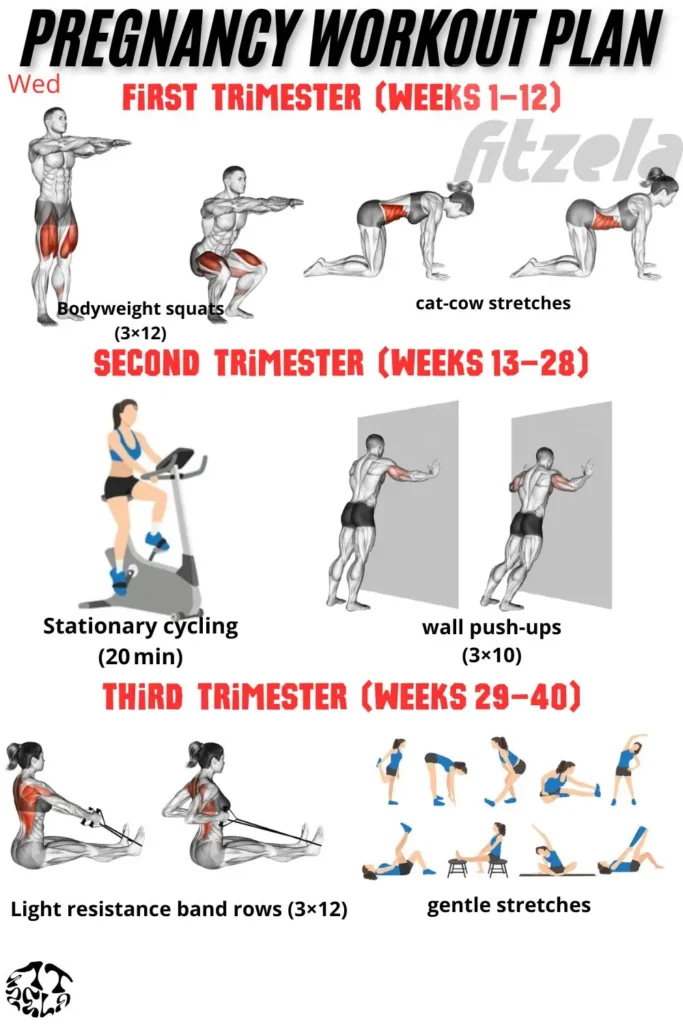What to Include in a Pregnancy Workout Plan for Healthy Prenatal Fitness
Embarking on a pregnancy workout plan can be one of the best ways to support a healthy, active pregnancy—so long as it’s safe, structured, and tailored to your body’s changing needs. In this comprehensive guide, we’ll walk you through everything you need to include in a prenatal fitness program, from medical clearance to trimester-specific routines, essential exercises, nutrition tips, and personalization strategies. Let’s dive in!
Table of Contents
1. Understanding Prenatal Exercise Basics

Physical activity during pregnancy is not just safe—it’s recommended. A well‑designed pregnancy workout plan takes into account:
- Physiological Changes: Hormonal shifts (e.g., relaxin) increase joint laxity.
- Center of Gravity: Your balance and posture will adapt as your bump grows.
- Cardiovascular Adjustments: Resting heart rate rises; perceived exertion may feel higher.
“Movement during pregnancy strengthens both body and mind, preparing you for labor and motherhood.” – Dr. Maria Gonzalez, OB/GYN and Maternal Health Specialist.
2. Top Benefits of a Pregnancy Workout Plan
Investing in a safe prenatal exercise routine yields lasting advantages:
- Reduced Pregnancy Discomfort: Eases back pain, swelling, and constipation.
- Enhanced Mood & Energy: Exercise combats prenatal fatigue and reduces anxiety.
- Better Sleep Quality: Regular activity helps you fall asleep faster and stay asleep longer.
- Easier Labor & Recovery: Stronger muscles and cardiovascular fitness shorten labor and speed recovery postpartum.
Data Insight: Expectant mothers who exercise regularly report a 30% lower risk of gestational diabetes and a 25% decrease in cesarean delivery rates.
3. Getting the Green Light: Medical Clearance & Timing
Before starting any pregnancy workout plan, consult your healthcare provider. Typical guidelines:
| Pregnancy Phase | Recommended Start | Key Checklist |
|---|---|---|
| First Trimester | After positive prenatal visit | No contraindications (bleeding, severe nausea) |
| Second Trimester | Week 13–28 | Monitor heart rate (stay < 140–150 bpm) |
| Third Trimester | Week 29–40 (low impact only) | Avoid supine positions; focus on stability |
Tip: Keep intensity moderate—talk testable (able to hold a conversation) and keep RPE (Rate of Perceived Exertion) ≤ 6/10.
4. Key Principles for Safe Prenatal Fitness
In designing your pregnancy workout plan, adhere to these foundations:
- Moderation Over Intensity: Prioritize consistency with low‑to‑moderate effort over pushing to fatigue.
- Core & Pelvic Floor Focus: Gently engage transverse abdominis and practice pelvic tilts, avoiding intense crunches.
- Avoid High-Risk Movements: Skip contact sports, ballistic movements, and deep twists.
- Hydration & Temperature Control: Avoid overheating, especially in hot yoga or saunas.
- Listen & Adapt: Modify or pause an exercise if you experience dizziness, pain, or shortness of breath.
5. Sample Pregnancy Workout Plan by Trimester


| Day | First Trimester (Weeks 1–12) | Second Trimester (Weeks 13–28) | Third Trimester (Weeks 29–40) |
| Mon | Brisk walking (20 min) + pelvic tilts (3×10) | Swimming (30 min) + side‑lying leg lifts (3×15) | Prenatal yoga (30 min) + seated marches (3×12) |
| Wed | Bodyweight squats (3×12) + cat‑cow stretches | Stationary cycling (20 min) + wall push‑ups (3×10) | Light resistance band rows (3×12) + gentle stretches |
| Fri | Kegels (3×15) + standing calf raises (3×15) | Modified plank (3×20 sec) + bird‑dog (3×10) | Seated banded leg extensions (3×12) + deep breathing |
| Sat | Rest or gentle walk | Prenatal Pilates (20 min) | Pelvic floor release (3 min) + walking (15 min) |
Perform workouts on non‑consecutive days; include 5–10 min warm‑up and cool‑down.


6. Essential Exercises for Your Pregnancy Workout Plan
Incorporate these categories to ensure balanced prenatal fitness:
- Cardio: Walking, swimming, stationary cycling, low‑impact aerobics.
- Strength & Stability: Squats, wall sits, resistance band rows, heel raises.
- Core & Pelvic Floor: Pelvic tilts, Kegels, heel slides, side‑lying leg lifts.
- Flexibility & Mobility: Cat‑cow stretches, prenatal yoga flows, hip openers.
7. Nutrition & Recovery to Support Prenatal Workouts
Fuel your body and aid recovery with:
- Macronutrient Balance: 60% complex carbs, 20–25% protein (1.1 g/kg), 15–20% healthy fats.
- Hydration: 2.3 L of water/day; add electrolytes after sweaty sessions.
- Micronutrients: Ensure adequate folate, iron, calcium, and vitamin D intake.
- Rest & Sleep: Aim for 7–9 hours/night and incorporate naps if needed.
Quick Recipe: Smoothie with Greek yogurt, spinach, banana, chia seeds, and almond milk—packed with protein, fiber, and micronutrients in under 5 minutes.
8. Tracking Progress & Staying Motivated
Consistency is key. Use these strategies:
- Pregnancy Fitness Journal: Record workouts, energy levels, and any symptoms.
- Wearable Tech: Monitor daily steps (target 7,000+), active minutes, and sleep quality.
- Visual Milestones: Take monthly photos to celebrate strength and posture improvements.
- Community Engagement: Join prenatal exercise classes or online groups for support.
Challenge: Share your Week 2 swimming session on social media with #PrenatalProgress.
9. Personalization & Data‑Driven Insights
Customize your pregnancy workout plan based on individual needs:
- Morning Sickness: Opt for short, light sessions like walking if nausea peaks.
- High-Risk Pregnancy: Adhere strictly to provider guidelines and focus on gentle stretching.
- Fit Mom-to-Be: Add light dumbbells (1–3 kg) or resistance bands to maintain strength.
- Data Insight: Women who follow trimester‑specific plans report 40% less lower‑back pain by Week 20.
Expert Tip: Use perceived exertion scales rather than heart rate zones, as pregnancy alters cardiac responses.

10. Conclusion & Next Steps
Designing a comprehensive pregnancy workout plan ensures you stay strong, energised, and prepared for labour and motherhood. You’ll enjoy a healthier, happier pregnancy by following evidence‑based guidelines—incorporating trimester‑appropriate exercises, balanced nutrition, and personalised adaptations.
Action Items:
- Schedule your prenatal fitness clearance with your healthcare provider.
- Print or save this guide for easy reference throughout your pregnancy.
- Bookmark two trusted prenatal exercise video channels for form guidance.
- Join our free weekly newsletter for trimester‑specific tips and workout PDFs.
Ready to embrace prenatal fitness? Let’s get moving safely and confidently, one Trimester at a time!
Note: Always consult a healthcare professional before changing your exercise routine during pregnancy.









Leave a Reply